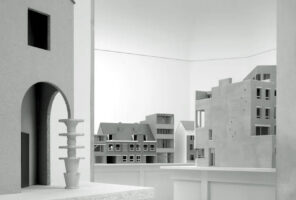Composite Presence – Composite Future
Published as: Hans van der Heijden, Surrogaat voor de eenheid van de stad, De Architect #3, September 2021
 The Belgian Biennale Pavilion in Venice, 16:00, 28 August 2012: culture minister Joke Schauvliege opens de exhibition The Ambition of the Territory. Her ambitions are clear: Belgian architecture must go international. Belgium should be in the ‘top 3’ of the world within ten years. An hour before, the Dutch pavilion had opened. While Minister Schauvliege stood with her back to the pavilion and addressed the gathered audience in the Giardini, an inward-looking party took place in the Dutch pavilion. Those intimates who could get inside were complicating themselves over a moving curtain ‘that gave the space different dimensions all the time’. Outside, people chuckled contemptuously. One Flemish architect sniggered that this could be the undisputed main attraction of a furnishing design biennial.
The Belgian Biennale Pavilion in Venice, 16:00, 28 August 2012: culture minister Joke Schauvliege opens de exhibition The Ambition of the Territory. Her ambitions are clear: Belgian architecture must go international. Belgium should be in the ‘top 3’ of the world within ten years. An hour before, the Dutch pavilion had opened. While Minister Schauvliege stood with her back to the pavilion and addressed the gathered audience in the Giardini, an inward-looking party took place in the Dutch pavilion. Those intimates who could get inside were complicating themselves over a moving curtain ‘that gave the space different dimensions all the time’. Outside, people chuckled contemptuously. One Flemish architect sniggered that this could be the undisputed main attraction of a furnishing design biennial.
A decade later: it has worked, Belgium is on the international architectural map. The giggling colleague of yesteryear, Dirk Somers, is curating the Belgian contribution to the 2021 Architecture Biennale which asks the question: How will we live together? Somers’ installation is called Composite Presence and consists of a collage of 45 large scale models. At the size of dolls’ houses, an imaginary city has been built, expressing design work in the fragmented Flemish city.

An imaginary city was built to the size of dolls’ houses, expressing the design work in the fragmented Flemish city. The models are placed slightly below eye level which promotes a realistic experience of a cityscape. There are 45 picture postcards on which a range of international architects depict the future city. With conviction, I accepted Dirk Somers’ invitation to make one too, as I am particularly envious of Flemish architectural practice and feel indebted to De Singel’s countless initiatives in Antwerp.
The exhibition catalogue documents the models and realised structures they represent. It is well known. The Flemish city is much less planned than the Dutch. Composite Presence reflects a practice of small-scale architectural interventions in that city without overly slick maquettes. The model landscape breathes painterliness, which has been characterised as ‘modesty’ in earlier columns of De Architect. The everyday repertoire of roofs, windows, proportions, bricks and lintels – especially lintels – is enthusiastically distorted, cropped, differentiated and magnified. As with any kind of mannerism, this sometimes leads to artifice (Jan de Vylder’s models, for example). The installation makes the case that contemporary building practice, with its unavoidably smooth and perfect products, can offer an analogy to the patinated, material historical city.
The merit of the essays in the catalogue is that they offer a glimpse behind the success presented. It is well known how the discourse in Flanders is promoted and maintained with all its might via architecture policy. For years, the Architecture Book of Flanders has been building the picturesque canon that returns in Composite Presence. The open call offers fair opportunities to both young and established architects. A system of quality chambers, architecture centres, city masters and state architects has been rigged. In his essay, André Loeckx congratulates the designers, but points out the indispensable power of what he calls the mediators. Mediating is designing and the mediators are co-authors, he argues. Irina Davidovic goes further, noting that Somers’s installation points to ‘a shared architectural culture as a surrogate for the irredeemable unity of the city’.
Surrogate. In his contribution, the Antwerp ‘mediator’ and City Architect Christian Rapp theorizes a diffuse city, which includes the periphery in addition to the historic city center. He refers to the Critical Reconstruction and the concept of Weiterbauen in the city of Berlin.
It remains to be seen whether Rapp’s diffuse city can reproduce itself. Implicitly, and probably unintentionally, such an assumption confirms Davidovic’s conclusion. After all, Berlin’s reconstruction was entirely planned and the result of the pregnant political choice to restore the spatial unity of the torn city. Individuals like the democratically elected Senatsbaudirektor Hans Stimmann propagated that urban policy, guided professional debate and operationalised architectural design, including through the publication of plan maps. Just as those maps went beyond simple reproduction and ‘critical reconstruction’ never aspired to surrogates, Stimmann went far beyond a role of mediator or co-author.

Does Composite Presence institutionalise the status quo of the picturesque Flemish city as a wishful thinking? Isn’t that thinking too defensively? Have mediation and micro-negotiation evolved from means to ends in themselves? Aren’t there any shopping malls, business parks, flyovers and hospitals being built in Belgium? How do such major investment flows find their place in the Flemish Architecture Books and in the policies that precede them? Is a Composite Future conceivable?
When asked, curator Dirk Somers e-mailed back: ‘I try to put forward the dynamics between the midfield on the one hand (e.g. the city architects, the Flemish master builder, the quality chambers, etc.) and the designers on the other hand as a model to tackle and improve places with a weak urban planning foundation. So where masterplan, urban planning and regulation did not work, or came a bit too late, it is dialogue, the “negotiated city”, that can succeed. Still work to be done…’